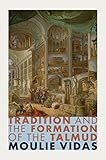Tradition and the Formation of the Talmud / Moulie Vidas.
Material type: TextPublisher: Princeton, NJ : Princeton University Press, [2014]Copyright date: ©2014Edition: Core TextbookDescription: 1 online resource (256 p.)Content type:
TextPublisher: Princeton, NJ : Princeton University Press, [2014]Copyright date: ©2014Edition: Core TextbookDescription: 1 online resource (256 p.)Content type: - 9780691154862
- 9781400850471
- Jewish law -- Interpretation and construction
- Religion -- Judaism -- General
- Talmud -- History
- RELIGION / Judaism / Talmud
- Amoraic tradition
- Babylonian Talmud
- Bava Qamma
- Christian literature
- Christian sources
- Christianity
- Christians
- Hekhalot literature
- Hekhalot tradition
- Israel
- Jewish culture
- Jewish genealogy
- Jewish history
- Jewish people
- Jewish tradition
- Jews
- Judaism
- Mesopotamia
- Oral Torah
- Palestinian Talmud
- Rav Yehuda
- Sar ha-Torah narrative
- Scripture
- Torah study
- Written Torah
- Zoroastrian literature
- Zoroastrian ritual
- Zoroastrian sources
- anonymous layer
- apodictic rulings
- attributed rulings
- authority
- composition
- dialectic
- discontinuity
- genealogical knowledge
- genealogical tradition
- intellectual history
- layered structure
- literary design
- liturgy
- mystical Jewish sources
- oral tradition
- rabbinic culture
- rabbis
- recitation
- religious text
- sacred texts
- scholarship
- self-definition
- self-presentation
- stam
- sugya
- sugyot
- tanna'im
- tradition
- 296.125066 23
- BM501 .V53 2017
- online - DeGruyter
- Issued also in print.
| Item type | Current library | Call number | URL | Status | Notes | Barcode | |
|---|---|---|---|---|---|---|---|
 eBook
eBook
|
Biblioteca "Angelicum" Pont. Univ. S.Tommaso d'Aquino Nuvola online | online - DeGruyter (Browse shelf(Opens below)) | Online access | Not for loan (Accesso limitato) | Accesso per gli utenti autorizzati / Access for authorized users | (dgr)9781400850471 |
Browsing Biblioteca "Angelicum" Pont. Univ. S.Tommaso d'Aquino shelves, Shelving location: Nuvola online Close shelf browser (Hides shelf browser)

|

|

|

|

|

|

|
||
| online - DeGruyter Philosophy of Biology / | online - DeGruyter The Analytic Tradition in Philosophy, Volume 1 : The Founding Giants / | online - DeGruyter Analytic Philosophy in America : And Other Historical and Contemporary Essays / | online - DeGruyter Tradition and the Formation of the Talmud / | online - DeGruyter Inside Paradise Lost : Reading the Designs of Milton's Epic / | online - DeGruyter Changing the World : American Progressives in War and Revolution / | online - DeGruyter The Voice of the Poor in the Middle Ages : An Anthology of Documents from the Cairo Geniza / |
Frontmatter -- Contents -- A Note on Style Conventions -- Introduction -- Part I -- Chapter One. The Alterity of Tradition -- Chapter Two. The Division into Layers -- Chapter Three. Composition as Critique -- Part II -- Chapter Four. Scholars, Transmitters, and the Making of talmud -- Chapter Five. The Debate about Recitation -- Chapter Six. Tradition and Vision -- Conclusion -- Acknowledgments -- Bibliography -- Source Index -- Subject Index
restricted access online access with authorization star
http://purl.org/coar/access_right/c_16ec
Tradition and the Formation of the Talmud offers a new perspective on perhaps the most important religious text of the Jewish tradition. It is widely recognized that the creators of the Talmud innovatively interpreted and changed the older traditions on which they drew. Nevertheless, it has been assumed that the ancient rabbis were committed to maintaining continuity with the past. Moulie Vidas argues on the contrary that structural features of the Talmud were designed to produce a discontinuity with tradition, and that this discontinuity was part and parcel of the rabbis' self-conception. Both this self-conception and these structural features were part of a debate within and beyond the Jewish community about the transmission of tradition.Focusing on the Babylonian Talmud, produced in the rabbinic academies of late ancient Mesopotamia, Vidas analyzes key passages to show how the Talmud's creators contrasted their own voice with that of their predecessors. He also examines Zoroastrian, Christian, and mystical Jewish sources to reconstruct the debates and wide-ranging conversations that shaped the Talmud's literary and intellectual character.
Issued also in print.
Mode of access: Internet via World Wide Web.
In English.
Description based on online resource; title from PDF title page (publisher's Web site, viewed 30. Aug 2021)


